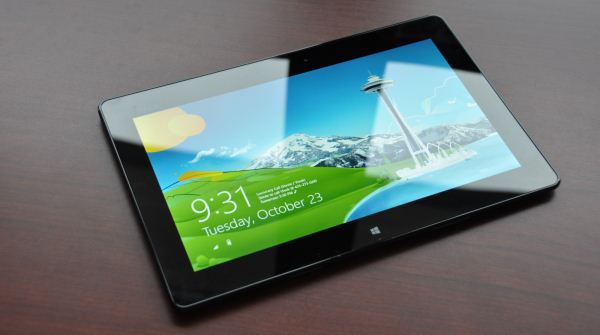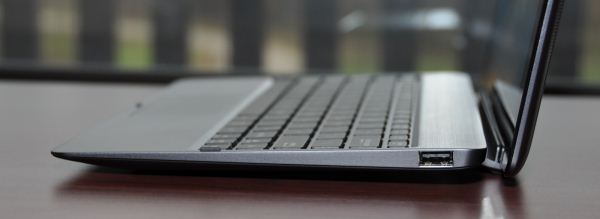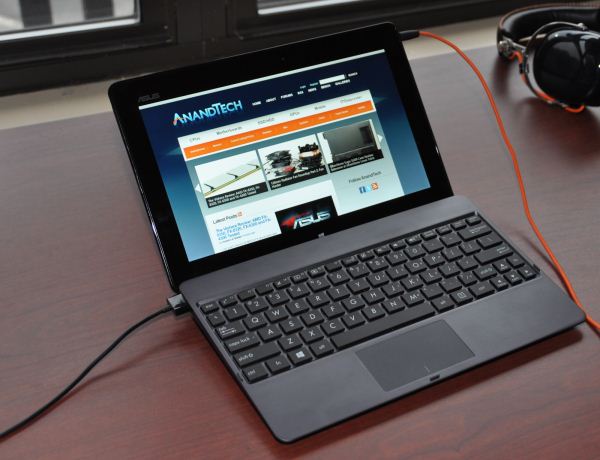ASUS VivoTab RT Review
by Vivek Gowri on October 23, 2012 3:01 PM EST- Posted in
- Asus
- Mobile
- Tablets
- Windows RT
- Vivo Tab
The VivoTab RT design is right in line with the last few Transformer releases - everything since the Transformer Prime has looked pretty similar, with a brushed metal aesthetic, chrome ASUS logo, and a mostly flat chassis with ergonomically curved edges. In the VivoTab, the top inch and a half is actually contoured plastic, while the rest of the back is brushed aluminum. The differences are all in the minor details, like the circular brushed aluminum finish from the Transformer Prime and Transformer Pad Infinity being replaced by a horizontal brushing, but the main design of the VivoTab RT is clearly derived from the Transformer line.
The front is almost identical to the Transformers as well, with one key exception - the capacitive Windows button located beneath the display. That means radiused edges, an ASUS logo silkscreened in the top left corner, and the weirdly off-center webcam. The buttons and ports are all located on the curved part of the chassis, with the power button on the top left corner, the headphone jack and volume control buttons on the right side, power/dock connector on the bottom (also weirdly off-center) along with latch points for the laptop dock, a latch release near the bottom of the left side, and finally the microSD card slot and microHDMI port also on the left side. Thankfully, the rear-facing camera is centered on the back and features a small LED flash alongside it.
This is the first time I’m seeing ASUS integrate the latch release slider on the tablet itself; previously that had always been located on the hinge of the dock. I don’t understand why they felt the need to locate the webcam and power connector away from the central axis, but it’s just a minor industrial design flaw that irks me and doesn’t affect the functionality in the slightest. Other ID nitpicks - the dummy microSD placeholder is just begging to be lost, and the plastic cover over the micro-HDMI port is fiddly and difficult to get on and off. Uncovered ports are the way to go - they just look and feel cleaner when integrated properly, like on the Transformer Infinity.
Speaking of the Infinity, the VivoTab uses the same NMT (nano molding technology) that debuted on the top of the line Android device earlier this year. NMT is described by ASUS as a process used to fuse plastic and aluminum particles together at a nano level using injection molding. I did a little bit more digging into the process and found that it involves a few steps. The stamped aluminum piece undergoes various surface treatment processes - first, being dipped in a basic solution to form a very fine etching on the surface - we’re talking nanoscopic scale here, with a surface roughness of 10 to 50 nanometers. The second surface treatment involves immersing the aluminum in a solvent that leaves the material covered by a thin film of amine (organic compounds formed by a basic nitrogen atom with a lone pair). Then a liquid thermoplastic resin is injected into the nanoscale dimples and react with the amines such that when the unit cools, the plastic is very strongly bonded to the original aluminum piece.
The thermoplastic compounds typically used in the NMT process are polyphenylene sulfide (PPS) or polybutylene terephthalate (PBT) depending on application, and can have a tensile strength of over 1500 psi. Both are highly crystalline engineering plastics, and exhibit significantly better mechanical and thermal characteristics than commodity plastics. The plastic infiltrates the aluminum during the injection molding and forms recesses that allow for a mechanical bond (ASUS uses the analogy of tree roots growing into the ground,) so the result is a composite material that is quite light. It allows internal plastic components to be integrated into the case, things like the internal frame and mounting points for the PCB and other various electronic components. This cuts down on additional part content by basically combining the internal frame with the external chassis, not to mention reducing or eliminating entirely the need for glue and fasteners. This in turn allows for thinner mechanical parts and a lighter and more structurally sound design overall. It’s pretty interesting stuff actually, and HTC was at one point rumoured to be making use of this technology as well.
I generally had no major issues with the design, except this: it felt too safe. Thin, light, and generally well-built, it does a good job of not making itself noticed. The “if it ain’t broke, don’t fix it” rule applies here, and it’s clear that ASUS didn’t want to mess too much with what has been a very successful design for them over the last twelve months. But in the face of some radical new redesigns for Windows RT and Windows 8 devices, I’d have liked to see ASUS take some risks here.
The dock has seen some updates as well, with each new Transformer shipping an iterated version of the trusty notebook dock. This is the newest yet, with a completely new unibody hinge design amongst other minor changes. I think the biggest difference is the latch mechanism, which has been moved to the tablet body. This gives the VivoTab RT the rather odd distinction of being one of the few slate tablets with moving mechanical assemblies (the Surface, of course, being another notable one). ASUS claims that makes it easier to dock and undock the tablet, which I disagree with, but it’s a minor usage difference. The dock features a 22Wh integrated battery that ASUS claims will extend the battery life of the tablet by another 7 hours. In addition, it has a USB port and the docking port. The 3.5mm audio jack is up at the top right corner, so it’s a little awkward looking when you have a headset plugged in. I’d categorize that as a minor ID flaw too, but it was a decision that was in all likelihood dictated by PCB layout, so I can’t fault them too much for it.
The keyboard remains pretty similar to what we’ve seen in the past, just with slightly different iconography and a Windows key replacing the Android home button. When docked, the capacitive Windows button on the tablet’s front face no longer works. Considering how difficult it is to press in when oriented as such, that’s not really a loss. The keys are obviously not full size, they’re about the same size as you used to find on netbooks - if you have small or nimble fingers, it’s not hard to get used to at all. I switched between a full sized desktop keyboard, a few different notebook keyboards, and the VivoTab dock without much trouble. Generally, I liked using the docking station, it was convenient, integrates seamlessly, and offers a pleasant typing experience. The amount of battery runtime it offers on top of that is simply awesome too - it’s incredibly liberating to literally never be concerned about whether or not your mobile computer has been charged. If I had an issue with it, it would be this: the dock takes an operating system designed around touchscreen input and puts it into a form factor optimized for mouse-based navigation - a natural segue to the next topic.















68 Comments
View All Comments
lmcd - Tuesday, October 23, 2012 - link
Either way just wait for S4 Pro tablets.VivekGowri - Tuesday, October 23, 2012 - link
It's got minor lag in desktop mode, noticeable but livable. Anything slower than T3 though, and livable quickly becomes intolerable. Most of the time, you live in Metro anyways so it's not that big of a deal.TrackSmart - Tuesday, October 23, 2012 - link
Just a heads-up, in case it is the Anandtech ad servers, and not my own system: Clicking between pages on this site, I got a popup that looks like adware. The link, after making it non-clickable was this: surveyorster dot net /d/j4u2i16147?r=http%3A%2F%2Fgjetefa.info%2Fin.php%3Fq%3DM%2FOEglLmwNcgOzwtBLg9uSk36%2BpwOyaQwIB9U0Q%3DI also saw an annoying "floating advertisement window" recently on the site, which I've never seen in the past.
I have not seen anything strange while browsing other websites.
shomizu9 - Tuesday, October 23, 2012 - link
In a google search, I'm seeing a few mentions of similar behavior involving the domain name "gjetefa.info" for other sites (wowhead, etc). I haven't personally seen any redirects like you mention on Anand. If it was my pc, I'd suspect malware and check it out with something like MalwareBytes.Urizane - Tuesday, October 23, 2012 - link
It has happened to me only twice. I don't remember the URL, but I have clicked on an article link from the main page, got the article, and one second later was presented with a page that copied the facebook design and called itself some kind of survey. I saw fields asking for my name and phone number and something else, but my CTRL+F4 reflexes kicked in. The next time I clicked on the article, that didn't happen. I got one roughly 2 weeks ago and another last Friday, and that's all. I think it's something that wedged itself into the ad rotation.michal1980 - Tuesday, October 23, 2012 - link
No offence to Vivek. But apple comes out with a "new" product, we get a 200 page in depth review with deep analysis from Anand.Microsoft releases both a huge new OS, a new tablet platform. and gets Vivek? And like 5 pages of coverage.
Unbiased? Just based on volume you can tell Anands bias.
VivekGowri - Tuesday, October 23, 2012 - link
You speak too soon, my friend. Between myself and Anand, we're dumping roughly 20k words of Windows RT-related coverage on you today. Just wait for the full Windows RT review.magnimus1 - Tuesday, October 23, 2012 - link
Vivek, This is a slight change of subject.....but do you guys have any plans to review the RAZRi?Also, Thanks for this article......are you going to do a similiar one for the Vivo Tab? I'm torn between the VivoTab and the full blown Transformer book. I need AT to help me choose!! :-)
darwinosx - Tuesday, October 23, 2012 - link
If you were actually familiar with the site or Apple products you would now they often take weeks longer than anyone else to write a review.Don't you need to run the malware scanner on your Android phone now?
Relic74 - Tuesday, January 1, 2013 - link
That is just silly, I personally have never gotten a malware nor have I ever met anybody who received one. If you stay away from cracked apps and add ridden games it should never be a problem. Besides I would gladly endure such a nuisance just to have a system that includes a filemanager, able to play almost every media codec, Java, Flash, SD Card slot, complete rom/system/data backup, ability to side load apps, true multitasking, multi-view, SAMBA/FTP/SSH support within the filemanager, DLNA, printer support, removable battery, NFC, ect. iOS is an overrated mobile OS but I'm glad your happy with it, that's all that matters.